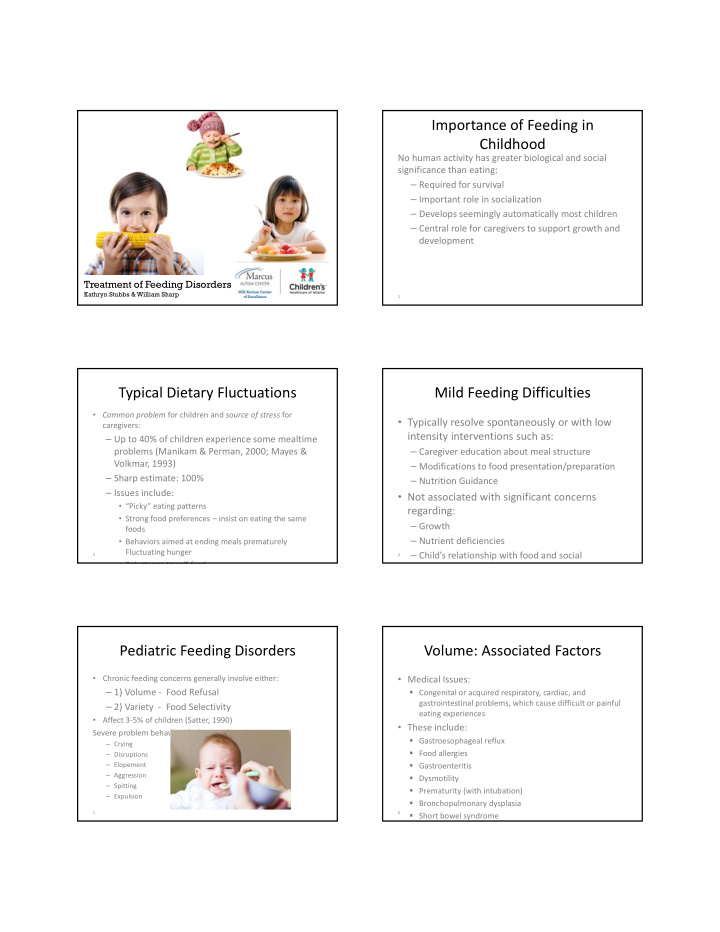



Importance of Feeding in Childhood No human activity has greater biological and social significance than eating: – Required for survival – Important role in socialization – Develops seemingly automatically most children – Central role for caregivers to support growth and development Treatment of Feeding Disorders Kathryn Stubbs & William Sharp 2 Typical Dietary Fluctuations Mild Feeding Difficulties • Common problem for children and source of stress for • Typically resolve spontaneously or with low caregivers: intensity interventions such as: – Up to 40% of children experience some mealtime problems (Manikam & Perman, 2000; Mayes & – Caregiver education about meal structure Volkmar, 1993) – Modifications to food presentation/preparation – Sharp estimate: 100% – Nutrition Guidance – Issues include: • Not associated with significant concerns • “Picky” eating patterns regarding: • Strong food preferences – insist on eating the same – Growth foods – Nutrient deficiencies • Behaviors aimed at ending meals prematurely Fluctuating hunger – Child’s relationship with food and social 3 4 • Reluctance to self feed Pediatric Feeding Disorders Volume: Associated Factors • Chronic feeding concerns generally involve either: • Medical Issues: – 1) Volume ‐ Food Refusal Congenital or acquired respiratory, cardiac, and gastrointestinal problems, which cause difficult or painful – 2) Variety ‐ Food Selectivity eating experiences • Affect 3 ‐ 5% of children (Satter, 1990) • These include: Severe problem behaviors during meals: Gastroesophageal reflux – Crying Food allergies – Disruptions Gastroenteritis – Elopement – Aggression Dysmotility – Spitting Prematurity (with intubation) – Expulsion Bronchopulmonary dysplasia 5 6 Short bowel syndrome
Variety: Associated Factors Marcus Feeding Disorders Program Multi ‐ Disciplinary Program: ~ 6,600 annual appointments • Autism Spectrum Disorder (ASD) Core Disciplines: – Behavioral Psychology – Oral ‐ motor (OT; SLP) – Nutrition – Gastroenterology Levels of Service: – Multidisciplinary Assessment – Outpatient Clinic (all disciplines) – Day Treatment Program Patients: – Not autism specific program – 60% = children with complex medical history and volume concern – 40% = children with autism and variety concerns 7 8 d = .45 Metric (small effect = .2, medium = .5, large = .8) MAC Feeding Program Research Mission • Expand evidence base to increase access to care by developing interventions that are: – Cost ‐ effective – Time ‐ efficient • With potential for: – Broad application – Rapid dissemination Marcus Autism Center 12
Programmatic Goals Randomized Clinical Trials • Expand the evidence base • The path to accomplishing the programmatic goals is through RCTs – Set national best practice standards • Promote replication and dissemination 1. DCS – Access to care 2. QuickWins • Explore avenues to increase effectiveness – Reduce length and cost Marcus Autism Center Marcus Autism Center Randomized Clinical Trials • The path to accomplishing the programmatic goals is through RCTs Use of D ‐ cycloserine to facilitate 1. DCS extinction of food aversion 2. QuickWins Marcus Autism Center D ‐ Cycloserine Current Uses in Psychology • ERP for anxiety disorders • What it is: – Antibiotic for treatment of tuberculosis • Most effective when administered immediately prior to or following – NMDA partial agonist exposure sessions • What it’s not: • Hypothesized mechanism of change: – Antidepressant – DCS enhances the acquisition and/or consolidation processes that occur during – Anti ‐ anxiety medication associative learning, in fear consolidation in – Antipsychotic particular – Anticonvulsant • Adult and pediatric populations (d=.9) Marcus Autism Center Marcus Autism Center
Hypotheses Study Design • Behavioral Intervention + DCS will make more rapid • 16 participants with food aversion randomly assigned (double ‐ blind) to one of two groups: improvement in mealtime behavior than Behavioral – Behavioral Intervention + Medication (DCS) Intervention + Placebo – Behavioral Intervention + Placebo • Mealtime behaviors: • First manual ‐ based behavioral intervention targeting feeding difficulties – Acceptance • Study timeline: study evaluation, medical evaluation, – Swallowing intensive behavioral intervention for one week (3 meals per – Crying day for 5 days) including caregiver training, and one month – Disruptions follow ‐ up with psychology and psychiatry – Expulsions • Children also receive DCS or placebo at the beginning of each – Pack treatment day Marcus Autism Center Marcus Autism Center Inclusion/Exclusion Criteria Treatment Manual • Inclusion • Standardized behavioral protocol – 18 months to 6 years • 8 Modules + increasing the volume of food – Partial food refusal with formula, bottle, or tube – Exposure/Response Prevention dependence (50% or greater) OR extreme food selectivity – Positive Reinforcement – Organic factor (GERD, food allergy) • Antecedent manipulations (e.g., bolus, • Exclusion texture) – Previous behavioral treatment at MAC Feeding Program • Consequences (e.g., REP, DRA) – Medically compromised, requiring current hospitalization – Unwilling to take study medication Marcus Autism Center Marcus Autism Center Pre/post Comparison of Differences Between Groups Feeding Conclusion from RCTs Behaviors, Grams Consumed, and Weight Status • These studies are an important first step in extending the evidence base for pediatric feeding disorders • The development and evaluation of this structured intervention establishes a platform for more systematic research in this area • Demonstration of feasibility and preliminary efficacy provide a basis for further study to test the efficacy of iEAT in large ‐ scale RCTs 23 Marcus Autism Center 24
Recommend
More recommend